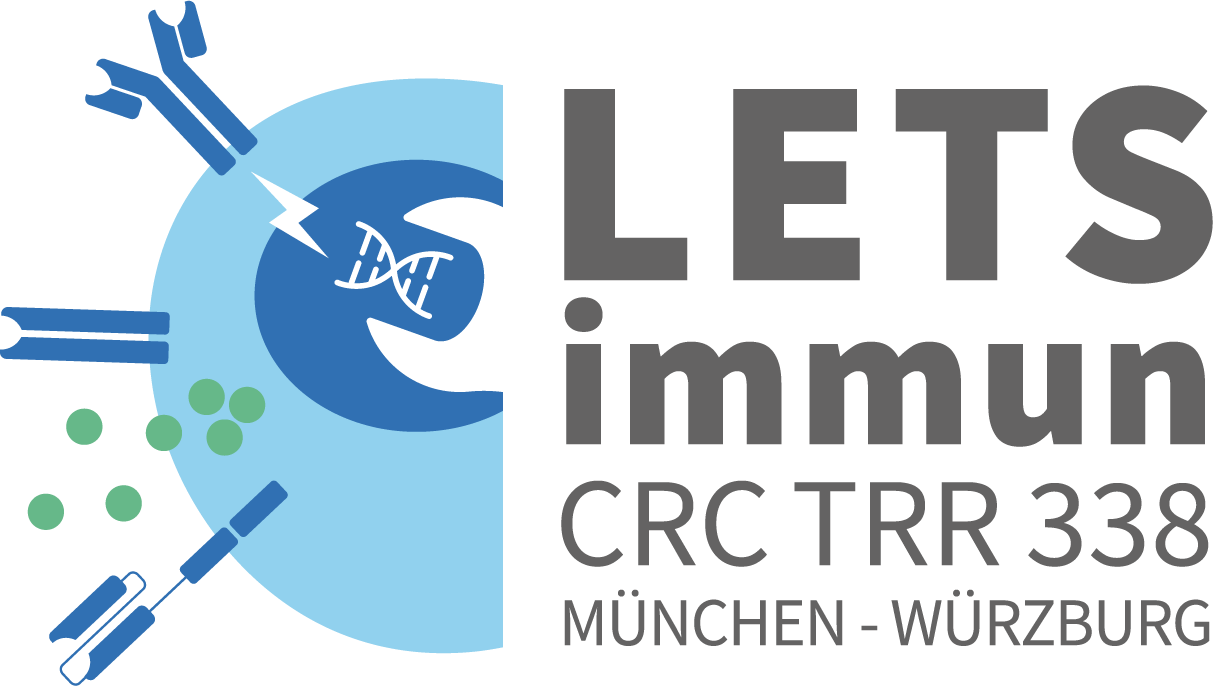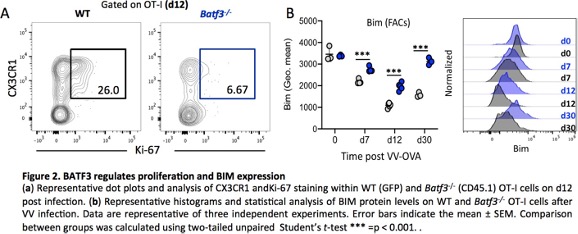Project Summary
In this research project we aim to investigate the therapeutic potential of engineered CD8 T cells in the context of adoptive immunotherapy against cancer. In our previous studies we found that the AP-1 family member BATF3 (basic leucine zipper transcriptional factor ATF-like) regulates the memory response of CD8 T cells by modulating their proliferation and survival in the context of acute and chronic infections in vivo. Utilizing kinetic analyses, transplant systems and three different infection models, we showed that all memory CD8+ T cell subsets, including central memory (TCM), effector memory (TEM) and peripheral memory T (TPM) cells were depleted in the Batf3–/– mice. Mechanistically, BATF3 primarily functioned by modulating the proapoptotic factor BIM while it did not impact on the differentiation of CD8 T cells.
Project-Related Publications
Ataide MA, Komander K, Knöpper K, Peters AE, Wu H, Eickhoff S, Gogishvili T, Weber J, Grafen A, Kallies A, Garbi N, Einsele H, Hudecek M, Gasteiger G, Hölzel M, Vaeth M and Kastenmuller W. (2020) BATF3 programs CD8 T cell memory. Nat Immunol.. Sep; 28
Borst J, Ahrends T, Bąbała N, Melief CJM, Kastenmuller W. (2018) CD4+ T cell help in cancer immunology and immunotherapy. Nat Rev Immunol. Oct;18(10):635-647.
Brewitz A, Eickhoff S, Dähling S, Quast T, Bedoui S, Kroczek RA, Kurts C, Garbi N, Barchet W, Iannacone M, Klauschen F, Kolanus W, Kaisho T, Colonna M, Germain RN and Kastenmuller W. (2017) CD8+ T cells orchestrate pDC – XCR1+ dendritic cell spatial and functional cooperativity to optimize priming. Immunity Feb 21;46(2):205-219.
Eickhoff S, Brewitz A, Gerner MY, Klauschen F, Komander K, Hemmi H, Garbi N, Kaisho T, Germain RN, Kastenmuller
W. (2015) Robust Anti-viral Immunity Requires Multiple Distinct T Cell-Dendritic Cell Interactions. Cell. Sep 10;162(6):1322-37.
Gasteiger G, Ataide M, Kastenmuller W. (2016) Lymph node – an organ for T-cell activation and pathogen defense.
Immunol Rev. May;271(1):200-20.
Glodde N, Bald T, van den Boorn-Konijnenberg D, Nakamura K, O’Donnell JS, Szczepanski S, Brandes M, Eickhoff S, Das I, Shridhar N, Hinze D, Rogava M, van der Sluis TC, Ruotsalainen JJ, Gaffal E, Landsberg J, Ludwig KU, Wilhelm C, Riek-Burchardt M, Müller AJ, Gebhardt C, Scolyer RA, Long GV, Janzen V, Teng MWL, Kastenmuller W, Mazzone M, Smyth MJ, Tüting T, Hölzel M. (2017) Reactive Neutrophil Responses Dependent on the Receptor Tyrosine Kinase c-MET Limit Cancer Immunotherapy. Immunity. Oct 17;47(4):789-802.e9.
Bedoui S, Gebhardt T, Gasteiger G, Kastenmuller W. (2016) Parallels and differences between innate and adaptive lym- phocytes. Nat Immunol. May;17(5):490-4.
Bald T, Quast T, Landsberg J, Rogava M, Glodde N, Lopez-Ramos D, Kohlmeyer J, Riesenberg S, van den Boorn- Konijnenberg D, Homig-Holzel C, Reuten R, Schadow B, Weighardt H, Wenzel D, Helfrich I, Schadendorf D, Bloch W, Bianchi ME, Lugassy C, Barnhill RL, Koch M, Fleischmann BK, Forster I, Kastenmuller W, Kolanus W, Holzel M, Gaffal E, Tuting T. (2014). Ultraviolet-radiation-induced inflammation promotes angiotropism and metastasis in melanoma. Nature 507: 109-13
Kastenmuller W, Brandes M, Wang Z, Herz J, Egen JG, Germain RN. (2013) Peripheral prepositioning and local CXCL9 chemokine-mediated guidance orchestrate rapid memory CD8+ T cell responses in the lymph node. Immunity. Mar 21;38(3):502-13.

